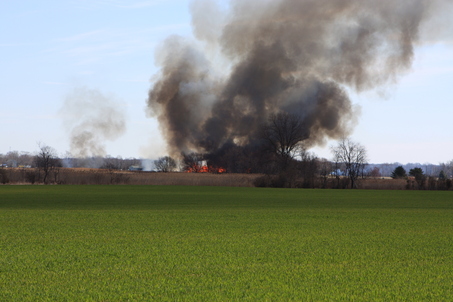
Back in the spring of 2009, I took a daytrip down to south jersey to spend the day rambling around.
I happened upon a “prescribed burn” that had gotten out of control and wrote about it briefly, with more photos here.
The so called “control burn” fire, which I assume was done for agricultural purposes, created a small wildfire that had several negative consequences.
It required emergency police and firefighter response, caused air pollution, threatened nearby farms and residential buildings, and potentially destroyed important ecological values, like habitat.
So, while I am aware of the natural and necessary role of fire in ecological dynamics, especially in Pinelands forests, today I was somewhat surprised to listen to some environmentalists unconditionally support a bill that would promote and loosen protections on “prescribed burns”. The bill would (See: S2169):
- make prescribed burns a “property right”
- put the NJ Forest Fire Service in complete control of the prescribed burn program with no mandatory safeguards and little public accountability
- fails to include technical requirements and public review of “prescribed burn plans”, such as surveys or safeguards to protect habitat, forests, threatened or endangered species, air or water quality, minimize safety risks or nuisance effects, or involve nearby property owners
- prescribed burn would be deemed to be in the public interest, would not constitute arson, trespass, or a public or private nuisance, and would not be considered to be illegal air pollution.
- eliminates any liability for damages caused by prescribed burns on private lands
Fire risks to the public and private property are largely caused by inappropriate development at the forest edge (and don’t forget that the “Tree Massacre” was justified by some at DEP as a fire prevention measure).
A prescribed burn program gives a false sense of assurance that fire risks can be managed, thus inviting more inappropriate deveopment in fire risk zone, like Pinelands forests.
There is also potential risks for prescribed burn to do real harms – and even if done safely, there are competing objectives at play.
As such, balancing risks and policy calls should not be made by the NJ Forest Fire Service without public involvement and clear legislatively established standards to safeguard against unintended consequences and risk to public safety, private property, and ecological resources.
And elimination of liability fro damages or injuries caused by “prescribed burns” invites a lower standard of care and raises risks – what is known as “moral hazard.
It is not good public policy to pass such a bill.
The environmental groups supporting the bill were acting more in their own interests as private landowners seeking to avoid public accountability and liability, than stewards of the public interest.

OMG – one word for this type of bill “insanity”.
Pingback: WolfeNotes.com » An Open Note to My Friends in Pompton Lakes
Pingback: WolfeNotes.com » “Forest Harvest” Bill Is Clearcut – Substitute Bill To Be Drafted
Pingback: Quantum Vision System Reviews